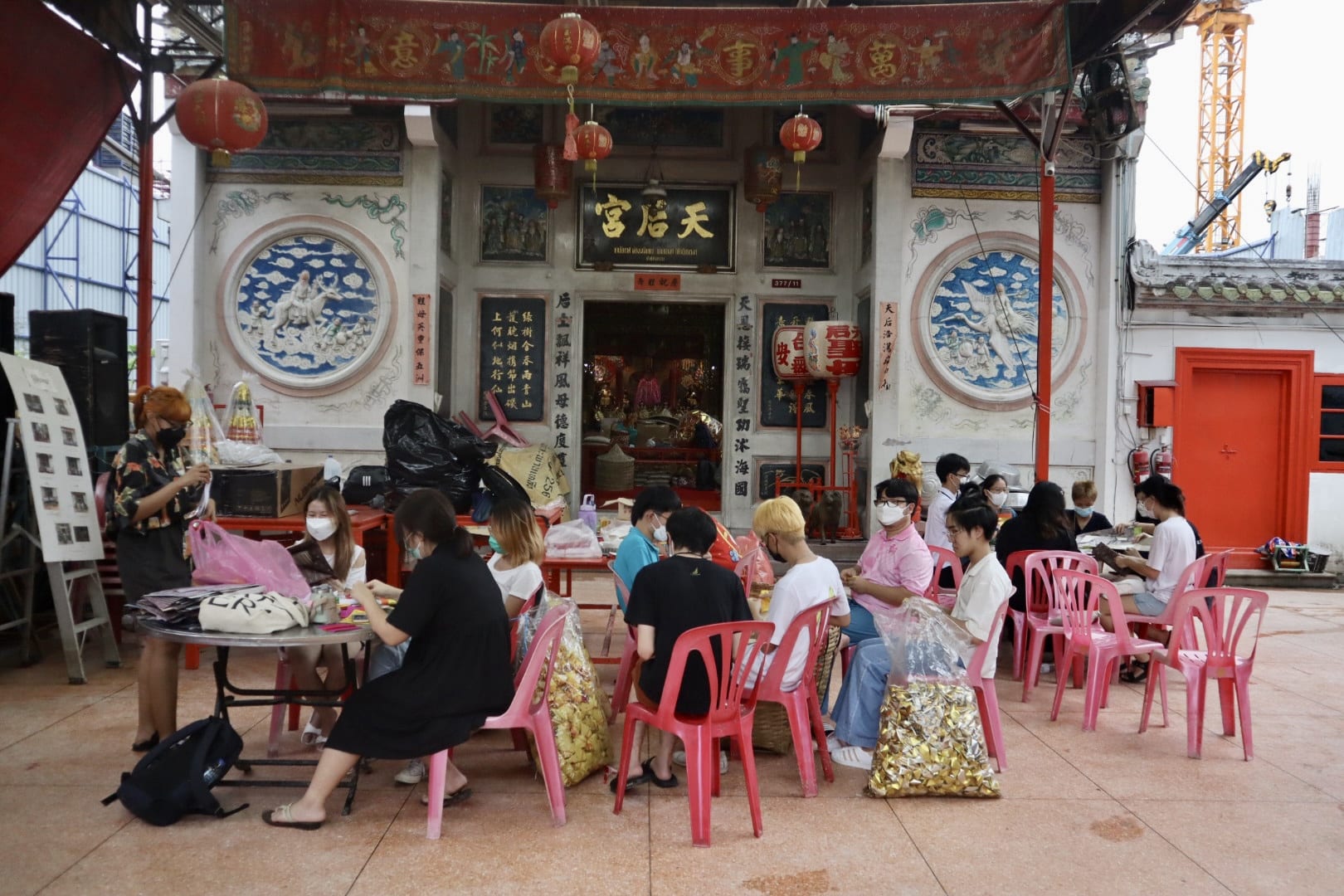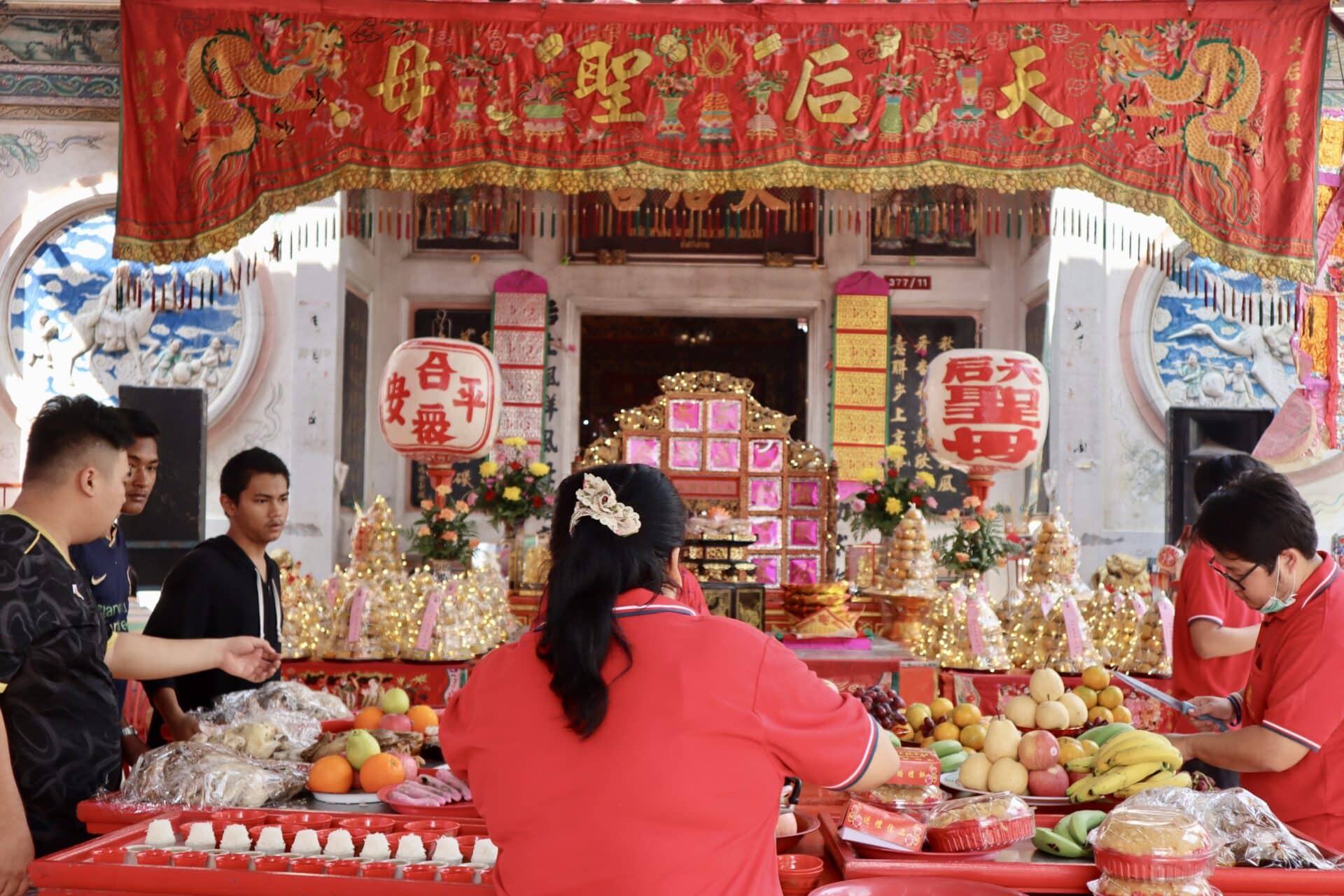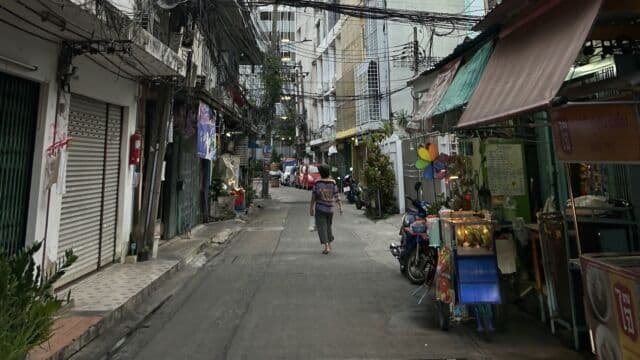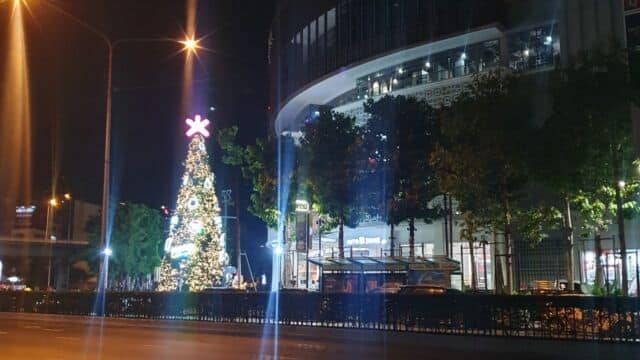Where Gentrification Comes For a Goddess
Construction presses in. Photo: Whispering Incense
Chao Mae Thap Thim shrine | 2,526 words
Translated from Thai by Wichayapat Piromsan
Standing in front of me is the shrine of Mazu, a Teochew place of worship that is like the last breath of the Samyan community.
Corrugated metal panels have been put up around surrounding construction sites. They stand tall, shooting up into the sky, hiding the shrine from outside view. Just a glimpse of the scene will tell you that the shrine is to be evicted. But P’Nok, inheritor of the shrine, has been standing her ground, protecting it.
Many people used to ask me where the shrine is. They said they had never seen it. I told them, “Well… it’s in the middle of those construction sites.” They were taken aback, and even more so when I pointed to a narrow alleyway where a small sign indicated a path to it.
This is the first time in almost a year that I’ve come back. The Hungry Ghost Festival is taking place here. Amidst the hustle and bustle, the shrine committee walk to and fro. At this time last year, I came to help prepare for the festival. There were only a few of us back then. Now after a year, the shrine is recognized by many more people. It’s as if I am witnessing the growth of some living creature, to see this shrine that previously had only a few volunteers. It’s like seeing the part of a movie where the conflicts are resolved, and we are easing into the denouement. This should be where the sweet ending comes and the credits roll. But what will unfold here is yet to be known.
“Sawatdi kha, P’Nok.” I put my palms together below my chin to greet P’Nok. An amiable woman in middle age, she gives me a quick smile before moving on to her task delegation. Seeing the shrine with this crowd and this liveliness, one might misunderstand and think everything is going well.
To the shrine come many believers paying homage to Mazu. Dozens of impoverished people queue for food and other basic sustenance, forming lines along both sides of the street. Gathered together they look like a gray mass in the middle of this prim and proper environment, which is within the grounds of a famous university, but features grand residential properties and shopping malls. The sight reminds me that the university is trying with all its might to maintain order and cleanliness, but only to pander to some people while marginalizing others.
I look around the shrine. Streams of memories of the past three years of struggle flow over me.
I started getting involved with the shrine in 2020, in my second year of political science at Chulalongkorn University. In a student group I participated in campaign activities as much as I could and got to know Netiwit, a student activist dedicated to social justice issues. We were in the same faculty. He was the one who got me involved in the campaign to protect the shrine.
I’m not from this neighborhood and am not directly affected. My Chinese blood is thin, and I usually go to temples only once in a blue moon. Frankly, this shrine and its affairs have nothing to do with me. But what would you do if an injustice was staring you in the face? Would you just acknowledge it and then walk away? I cannot.
The first time I went to the shrine with Netiwit and friends, we spoke to P’Nok and learned that the shrine was at risk of “eviction.” Chulalongkorn University, which is the land owner, wanted to demolish the shrine for a new condominium development. It sued the shrine for a nine-figure compensation for not moving out.
If Netiwit hadn’t invited me to join, I wouldn’t have known that a shrine is located here because all the skyscrapers hide it from view. Not far from my school buildings is Samyan Mitrtown, which is both a residential building and shopping complex. Most of my friends said they cannot afford to live there, not even to eat at the mall frequently.
“In this dog-eat-dog world, where the government cuts the education budget, educational institutions have to generate profits. And their way is to evict local communities and replace them with shopping complexes and condominiums. The shrine is next in line for demolition,” said Netiwit. Quite a disheartening statement.
You might think that this is legitimate, since the university (on behalf of its Property Management Division or PMCU) is the landowner—it can do whatever it wants with its land. But should it? Legal land ownership is a good enough justification for uprooting the local community, and destroying its arts, culture, and souls?
“I married into this family. I live here. This is my home,” said P’Nok while showing us around the shrine. She said that this kind of architecture can’t be found anymore. And that the calligrapher who painted the auspicious Chinese characters on the pillars has passed on.

The shrine is decorated with delicate murals and bas-reliefs in every corner. On the left and right walls are two giant bas-reliefs, one a tiger, the other a dragon. Sunbeams shining through the clerestory reveal a pond under sculptures. Turtles perch on the stones, and minnows swim. Standing tall and gracious in the middle of the shrine, among smaller statues, is the goddess Mazu herself. She is a wooden idol of compassionate countenance.
When I came here the first time, the beauty I saw imprinted itself on my heart. I knew that I wanted to come here as much as I could. The only thing I didn’t like was the incense. I had glanced at a scar on my hand that I got from an incense stick when I went to a temple with my parents as a child. Seeing my hesitation, P’Nok had taken the incense sticks from my hand, walked to the lantern, lit them, and handed them back to me with a smile.
As if reading my mind, she said, “the incenses are a medium for our prayers to be delivered to the gods.”
I smiled sheepishly but accepted the incense. I walked around the wooden idols before stabbing the sticks down into the pot like others were doing, but I didn’t make any wishes.
It was rainy season. The smell from the incense mixed with the rain and made me nauseated. The odor was sticking to my clothes. And I was suddenly not sure anymore if I wanted to come here all that often.
Streams of memories continue to wash over me.
“Should we appoint students to be committee members of the shrine?” asked Netiwit, when P’Nok mentioned the committees, people designated to organize festivals here. The members of the shrine committee are normally filled by senior citizens of the local community. But due to the conflict with the PMCU, the previous committee took most of the shrine’s money and ran to build a new shrine, leaving P’Nok here.
Not long after, a new committee of the shrine comprising students and P’Nok herself was established. Many of them were my seniors at the university and believers of Mazu. I didn’t know anything about the ceremonies, but I couldn’t just do nothing. Taking on miniscule tasks was the least I could do, apart from helping Netiwit with his symbolic protests to push forward this issue in seminars and talks.
It was also rainy season when the student committee of the shrine organized the Hungry Ghost Festival for that first year. The smell of soil and grass mixing with incense filled the air. We sat in a circle around a table, folding joss paper for the festival. The committee talked about the Chinese opera, the ceremony, and other cultural stuff that I couldn’t get into, but I wanted to be a part of the conversation.
“What ritual did you perform? Why did PMCU return the sign?”
We had put up a sign at the path to the shrine. It was a simple sign that the committee chipped in from their own pockets to have made. But the PMCU just took it away. If that wasn’t enough, they went on to advertise that this shrine no longer existed. The intention of taking the sign away was to conceal from people that the shrine was still here, still doing well, and that the Hungry Ghost Festival was about to take place.
“Psychological warfare. We performed a hex and then posted pictures of it on social media. We wrote that we put a curse on the sign thief and sent hungry ghosts after them to break their necks. The sign was back a few days later like it had never been taken.”
I was mesmerized by the response. I thought of all the sociological and literary theories from my textbooks. Magic and charms are weapons of people who have nothing else to fight back with. While the law and financial power is in the oppressor’s hands, what else do we have?
Like it or not, a question popped into my head: what’s the point of all this resistance? I didn’t get an answer before being pulled out of my reverie. Many adults in my life have warned me that there’s no way to win against the wealthiest, most powerful university in Thailand.
“These trousers should be paired with a top, and then you put this gold paper over it like this, then roll them all together.” As we continued to fold the joss paper, Art, a student committee member, explained how the paper garments work. It’s believed that spirits will use them in the afterlife.
“I didn’t add trousers to the tops for the ones in that pile…”
“Oh, it’s fine. They’ll figure it out up there.”
Art’s response cracked up everyone in the circle. I don’t know if there’s an afterlife. Or if the spirits will exchange things we send them among themselves. But I know that the faith these people have is real. I felt sadness materialize around me, thinking that one day, banter like this might no longer happen here.
Streams of memories keep flowing.
In the moon festival the following year, it was pouring so hard that we had to put chairs next to one another to form a bridge, then climb over them to avoid floods on our way out. P’Nok said the Goddess Mazu is the goddess of water, and that her idol was floating along the river when the ancestors of P’Nok’s husband discovered her.


“I know she is the goddess of water, but is this really necessary?” I thought, soaked from head to toe. P’Nok told me she had never seen it flood like this before, even when it rained a lot. The flooding got worse immediately after the shrine was surrounded by the construction sites. The drainage system around the university campus was already not good enough to handle this amount of water, then tall buildings combined with poor urban planning united to cause frequent disasters. It’s disconcerting to see new apartment buildings one after another, each one taller than the one before. They look horrendous. They are like monsters devouring the surrounding land. People say the shrine is the odd one out in the middle of such gentrification. But for me, those buildings are the odd ones.
I don’t like floods, but there was no other way. Whenever I got there to help prepare for the ceremony just before night fell, I knew I would be soaking wet on my way out.
“Is it worth it to be sopping wet like this…” said some of my classmates while feigning sobs. I knew they were just kidding. But it made me think: that’s true. When did I stop asking myself why I was doing this?
In the past few years, the things PMCU have done to P’Nok have been getting worse.
I remember P’Nok’s voice when she called me. “They did it again. There’s someone lurking around the shrine. It looks like they have something up their sleeves.” Or: “the fake shrine in CU Centennial Park is organizing some ceremony again. And they advertised that the goddess has been moved there.”
The PMCU also has tried to defame the shrine, spreading made-up stories of it being a hotspot for crimes and drugs. They treat us like we are lower. The negotiations failed from the beginning. They repeatedly initiated questioning in court. In every session, the PMCU would come off as the good guy, painting the shrine as the bad one. I would ask P’Nok what I could do. There was nothing else I could come up with, apart from bringing my friends along to help out, and continuing to tell the stories of the shrine to people. I thought of the saying: If people keep telling a particular story for a long enough time, it will become a main narrative of society. I hope the story of the shrine of Mazu will become a main narrative one day.
The streams of memories have not stopped. This time, many fragments rush back to me.
Puddles of water on the narrow path to the shrine on the morning after a night of rain. More people, sitting in a circle, folding joss paper. Hearing a conversation that I couldn’t quite understand. And the moon festival: the colorful decorations, the elderly Thai-Chinese couples walking hand-in-hand to see the Chinese opera, the spectacular costumes and high-pitched singing voices of the opera actresses. P’Nok’s voice calling everyone to have dinner after the ceremony. P’Nok’s five small dogs, competing for a place in my lap. I wonder where they will be if the shrine is demolished.
And in all this I see myself, who will inevitably change, in one way or another.
Of all the times I have been involved with this shrine, I thought I had done it because I felt obliged, but now I know it’s not just that. Deep in my heart, I know there’s something more. I know people are longing for a space where we can connect. The shrine is more than just the residing place of the gods and goddesses of the Samyan community. It represents lives, the struggle against capitalists and gentrification that has no mercy for individuals and the soul of the community. That fight, and every component that comes together to make this shrine what it is. I hope some of it survives.

These streams of memories bring me to the present. The smell of incense is diffused in the air. I walk through a throng of people towards the shrine. A young woman seems confused. It seems like this is her first time here. She doesn’t know the process, and doesn’t know who to ask. I walk toward her and explain, and hand her some incense sticks.
“And how are you?” P’Nok stops giving out offerings, comes towards me, and asks the question with a smile. I smile back and tell her about my life after graduation. We’ve not seen each other in almost a year. P’Nok’s eyes are as warm as they’ve always been.
In this visit to the shrine, I see something growing, and I pray that its growth will not be ended easily.
© Whispering Incense
English translation © Wichayapat Piromsan
Commissioning editor: Natcha Sinkeree





